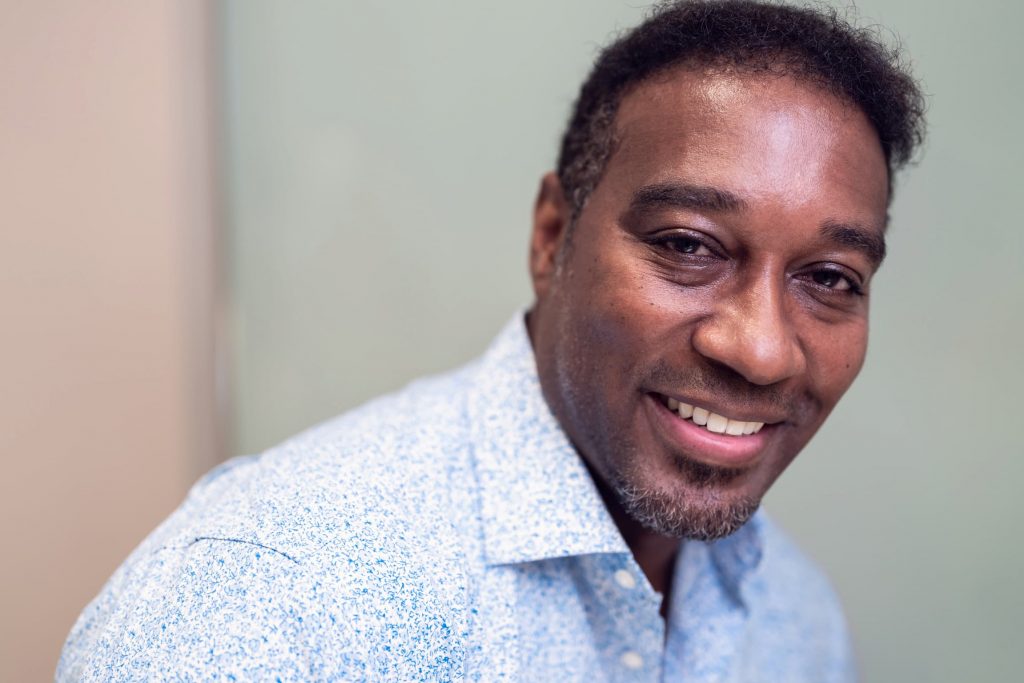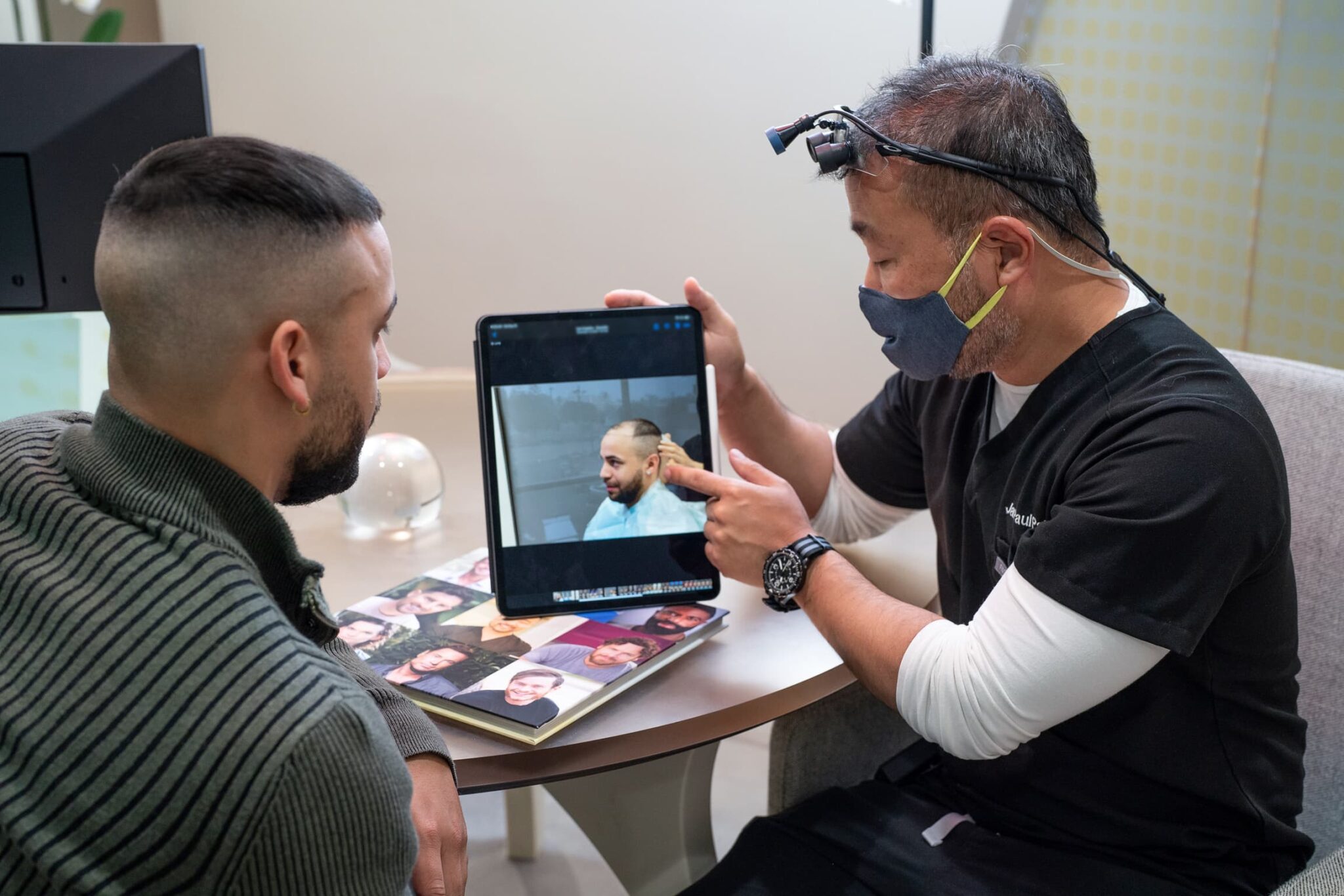
Actual Patient of Jae Pak, M.D
Impacting more than 50% of the male population, a receding hairline is a common and relatable experience. However, that doesn’t make it any less frustrating, as men often struggle to reverse the trend and bring that strong, youthful hairline back to full form.
When men first start to notice pattern balding in the predictable M-shaped pattern, the clock begins to tick. Noticeable hair loss usually means that the condition has progressed significantly, and visible changes have only just begun to show.
Remember – to treat a receding hairline, proactive measures are key. The earlier you get ahead of the problem, the better. There’s no time to waste if you want to save your remaining hair and have a chance at reversing course.
It’s also true that no two men are exactly alike in the cause or conditions of their hair loss. That’s why we’ve put together a list of 10 different treatments that can help men address a receding hairline and even replenish some of their lost hair.
We’ve drawn from natural remedies and lifestyle tips, as well as approved medicines and even surgical methods, giving you a range of options to see what works best for you. These treatments also increase in cost and commitment as the list progresses, so start with smaller measures before you work your way up. Let’s get started.
Optimizing your health and lifestyle should be the starting point to deal with any sort of ailment, cosmetic, physical, or mental.
Healthy living – diet, exercise, sleep, and low stress – means healthy hormones and plenty of blood flow to transport nutrients to your scalp. Studies show that better lifestyle choices can slow a receding hairline or even turn things around for renewed growth.
Take on healthy habits not just for your hairline, but for your happiness and longevity overall.
A balanced diet should give you the majority of the nutrients you need to promote a healthy hairline, but these days, a supplement boost may be needed to gain an extra edge.
Nearly all the well-known vitamins (vital minerals) are somehow related to hair health, so find a supplement that contains the major nutrients you recognize and know as essential.
Vitamin C, for example, is responsible for the creation of collagen, while vitamin D plays a role in creating new hair follicles.
Don’t forget minerals like magnesium, zinc, and iron – deficiencies in all three have been linked to hair loss as a result of decreased oxygen in the scalp.
While research is limited in the area of essential oils for hair health, it’s worth trying a range of different organic products before you reach for the more serious medicinal treatments or pursue a surgical procedure.
There are several essential oils linked to stronger, healthier hair, including peppermint, lavender, cedarwood, rosemary, and lemongrass.
When experimenting with these oils, be sure to dilute a very small amount in a “carrier oil” like coconut, jojoba, or black cumin seed oil, before application. These are powerful compounds that do not require a large dose to take effect.
Also, try only one oil at a time so you can identify how they function individually, rather than creating a mixture that obscures the ingredients that work best.
The other FDA-approved hair loss treatment is Finasteride, an oral medication in tablet form to be taken once daily.
The active ingredient in Finasteride aims to interfere with the function of DHT – a byproduct of testosterone linked to male pattern balding – in the scalp.
Because of its role in manipulating male hormones, Finasteride is only prescribed to adult men, but many studies have shown long-term effectiveness and satisfactory results. Most men report positive results within six months of taking Finasteride, while some experience no effect.
The big advantage of Finasteride over Minoxidil is the simplicity of administration. There’s no need to deal with a liquid treatment twice daily that may stain clothes or emit an odor.
Once again, Finasteride must be taken continuously to see positive effects, which will cease within a few months after stopping treatment.
Also, remember that both Minoxidil and Finasteride work best when taken early in the advancement of a receding hairline, so don’t delay at the first sign of hair loss.
The FDA has only ever approved two drugs to combat receding hairlines, and Minoxidil – better known as Rogaine – is the only topical treatment of its kind.
Minoxidil belongs to a class of drugs called vasodilators, meaning the active compounds work to increase blood flow to the area of application. This floods nutrients and oxygen to promote an intended effect, in this case, hair loss prevention and renewed hair growth.
In terms of application, Minoxidil does require some degree of patience and long-term commitment. The topical treatment must be applied twice daily, and patients must not skip sessions if they want to maximize results.
After three or four months, users will have an idea of whether the medication is working.
Furthermore, discontinuing the use of Minoxidil will bring users back to square one, losing any progress made in terms of hair loss slowing or reversal.
Despite these minor drawbacks, Minoxidil is still widely prescribed by hair loss specialists around the world.
With some clinical studies to back it up, along with anecdotal evidence from decades of public use, Minoxidil remains at the top of the heap for affordable, effective receding hairline treatment.
Microneedling, microchanneling, microdermabrasion, derma rolling – these non-surgical treatments aim to create small perforations in the skin to stimulate collagen production and achieve a range of cosmetic benefits.
There are many ways to go about microneedling and its many versions, including handheld DIY rollers that can be used for easy, safe at-home treatment.
However, for the best results, professional treatment is always preferred, maximizing the positive aspects of the technique while reducing side effects like scarring.
Microchanneling is considered the most effective and professional technique in this category, and treatments can be had for reasonable prices at many salons and clinics.
Using specific wavelengths of ultraviolet light, these treatments directly stimulate circulation in the scalp while energizing cells and promoting healthy hair from deep in the skin.
Red-light treatment is increasingly popular among athletes and physical therapy patients for its rejuvenating effects throughout the body, particularly in repairing joints, tendons, reducing tension, and inducing feelings of well-being.
These treatments come in many forms as well, including full-body beds with dozens of UV bulbs, smaller handheld light boxes for targeted treatment, and even helmets with built-in mini lights for maximizing effects on the scalp.
Researchers have been hard at work trying to crack the stem cell code for decades, and treatments for hair restoration are only just making their way to the mainstream.
The idea is to extract healthy stem cells from an area of the scalp with high follicle density, isolate the active cells with centrifugal force, then inject them back into the target area of the scalp in need of greater coverage.
Few clinics offer proven stem cell therapy for hair loss at this point, but it’s worth watching in the years to come.
These time-tested surgical methods deliver the most compelling and permanent results of any treatment on our list. The client’s real hair is harvested from the donor area on the back of the head, then dissected into follicle units before implantation onto the hairline.
FUT – also known as strip surgery – is the older of the two treatments, but tends to be more affordable and widely practiced. FUT does leave a linear scar, however, on the donor area due to the extraction of the strip of hair-bearing skin.
FUE is a modern alternative to FUT that allows surgeons to individually extract follicles from the donor area, skipping the horizontal scar. However, yields may be lower, and the cost of FUE tends to be higher.
For men who wear their hair in a buzz-cut style, Scalp MicroPigmentation offers a cosmetic treatment in the form of a precise hair “tattoo” to fill in gaps on the scalp.
SMP treatments look remarkably natural and realistic when performed by reputable surgeons, and the results can last for years before only minor touch-ups are required.
Do your research when looking for SMP treatment, however, because many unqualified practitioners are offering the service with insufficient abilities, experience, or best practices.
Envision your new hairline today. Schedule a consultation with Jae Pak, M.D.
Request a Consultation
Trial and error will only get you so far in fixing a receding hairline. To tackle the problem directly, you need to leap into action with a multi-faceted game plan.
Team up with a trusted hair restoration specialist to plan ahead and execute a strategy that works best for you.
Sources:
Alternative Treatments for Alopecia | NIH
Speak with Jae Pak, M.D. today!
Request a Consultation